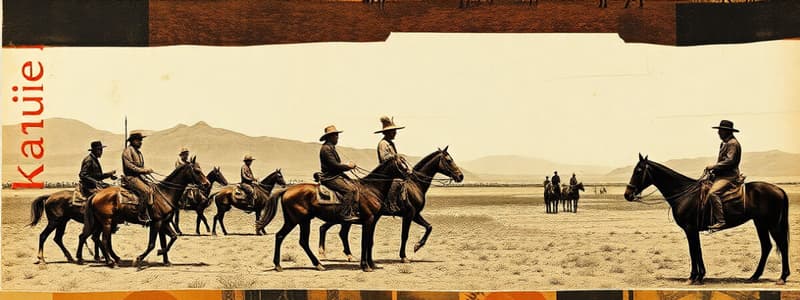Podcast
Questions and Answers
What was the primary goal of the U.S. Army in the Western Indian Wars?
What was the primary goal of the U.S. Army in the Western Indian Wars?
Which of the following was NOT a significant resource extracted from the American West during the late 19th century?
Which of the following was NOT a significant resource extracted from the American West during the late 19th century?
What was a major impact of the Transcontinental Railroad on the American West?
What was a major impact of the Transcontinental Railroad on the American West?
What was the significance of the Homestead Act of 1862?
What was the significance of the Homestead Act of 1862?
Signup and view all the answers
How did the hunting of buffalo impact certain Plains Indian tribes?
How did the hunting of buffalo impact certain Plains Indian tribes?
Signup and view all the answers
Which of the following was a major battle fought during the Western Indian Wars?
Which of the following was a major battle fought during the Western Indian Wars?
Signup and view all the answers
What was the main purpose of the Sears Catalogue?
What was the main purpose of the Sears Catalogue?
Signup and view all the answers
Which of the following is NOT a term associated with the industrialization of the American West?
Which of the following is NOT a term associated with the industrialization of the American West?
Signup and view all the answers
Which of the following industries played a significant role in connecting the East and West?
Which of the following industries played a significant role in connecting the East and West?
Signup and view all the answers
What was a major consequence of the Western Indian Wars for Native American tribes?
What was a major consequence of the Western Indian Wars for Native American tribes?
Signup and view all the answers
Flashcards
Transcontinental Railroad
Transcontinental Railroad
A railroad that connected the east and west coasts of the United States, completed in 1869.
Pacific Railway Act
Pacific Railway Act
Legislation that provided federal support for building the Transcontinental Railroad during the Civil War.
Homestead Act
Homestead Act
A law passed in 1862 that provided 160 acres of free land to those who worked it for five years.
Western Indian Wars
Western Indian Wars
Signup and view all the flashcards
Buffalo Hunting
Buffalo Hunting
Signup and view all the flashcards
Little Bighorn
Little Bighorn
Signup and view all the flashcards
Wounded Knee
Wounded Knee
Signup and view all the flashcards
Sears Catalogue
Sears Catalogue
Signup and view all the flashcards
Treaty of Laramie
Treaty of Laramie
Signup and view all the flashcards
Reservations
Reservations
Signup and view all the flashcards




